Peppers and tomatoes are highly responsive crops to fertilization. If you want the plants to please you with an excellent harvest, then from the first days of planting seedlings, you need to make sure that the soil contains all the necessary trace elements for its growth and development. And since they will absorb them quickly and rather diligently, pepper fertilizers will have to be applied regularly as the seedlings grow.

Main Challenges
When talking with gardeners, you often hear that they stop growing peppers on their plot. This is due to some difficulties, which is the cultivation of a heat-loving crop in our climatic conditions. Few people know that this is a perennial shrub, but we cultivate it exclusively as an annual plant. Its fruits are loved by everyone, they are used to prepare salads, first and second courses, and are sources of vitamins and minerals.
Is it difficult to grow them inRussia? Let's just say that it is possible, subject to a number of rules. We do not take into account the southern regions of the country. This crop has a long growing season, which means that in many regions of the country, planting seedlings begins in February. This gives the plant a chance to bloom and grow fruits in a short, hot period. In addition, timely weeding and watering, loosening are very important factors. Do not forget to fertilize the soil on time. For pepper, this is one of the foundations of normal life.
Growing seedlings
To get a good harvest, it is necessary to sow seeds in the ground in late January - early February. To do this, you need to prepare the boxes in advance, fill them with soil, water. After a couple of days, you can start planting seeds. The composition of the soil is the same as that which will be used for subsequent cultivation in open ground, greenhouses or greenhouses. You will need two parts of the earth, one peat and one humus. Everything is thoroughly mixed. If you take garden soil, then do not forget to disinfect it with potassium permanganate or exposure to high temperatures.
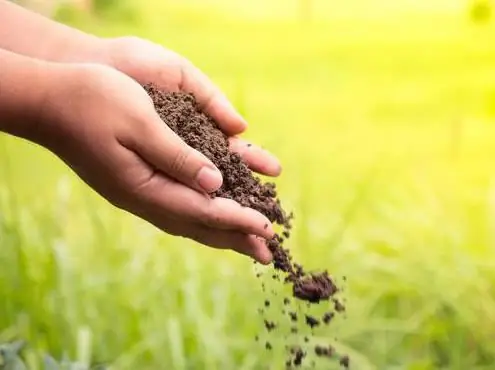
First feeding
Pepper fertilizer is a source of life and he alth. Only on nutrient-rich soil will seedlings grow strong and he althy. This means that it will easily transfer the transplant to open ground and take root without any problems. As soon as the seedlings have the first true leaves, it is necessary to feed them. The second stage - two weeks after the pick. Seedlings for the last timefeed 10 days before planting in the ground. Further, all activities will be carried out at the main place of residence.
Best cast
The ideal fertilizer for peppers during the first weeks of seedling life is complex, nutrient mixtures in which the nitrogen content prevails. If you have nowhere to buy it, then you can cook it yourself. There is nothing difficult in this. It is enough to dissolve 1.5 g of potassium s alt and 0.5 g of urea, as well as 4 g of superphosphate in one liter of water. This is the starting composition, which will enable the plants to quickly gain strength and begin to grow. Top dressing of pepper seedlings is carried out by watering the pre-moistened soil with a nutrient composition.
As soon as the plants release the second and third leaves, it's time to start picking. It is best if these are immediately cups designed for an individual fit. For example, peat.
Immediately after this, another feeding of pepper seedlings follows. It is best to use urea for this. To do this, dissolve one tablespoon of the substance in 10 liters of pure water. For the third time, immediately before planting in the ground, preparations containing nitrogen and phosphorus are used. Small amounts of potassium are acceptable.
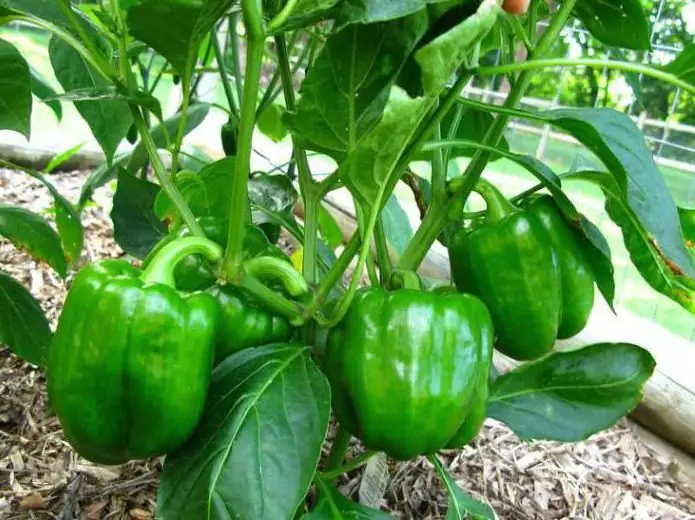
Optimal dosage is the key to success
Fertilizers for the growth of seedlings of pepper should be supplied to the soil regularly, this is an essential guarantee of good growth and future harvest. Young peppers are the most unpredictable of all garden plants. They cangrow and develop normally, and suddenly, in an instant, they begin to dry out. Experienced gardeners say that this is just the result of a lack of nutrition. If you urgently apply top dressing, then the situation can still be saved.
It is useful to know what functions this or that substance has. Nitrogen is extremely necessary for building up the green mass of the stem, phosphorus - for a powerful root system. But the seedlings almost do not use potassium, it will be needed much later. But the number is a little more difficult to determine. Based on practical experience, we can say the following. As long as the plants are developing well, have thick stems and well-developed leaves, you can not bother to fertilize. And as soon as growth retardation is diagnosed, you can correct this situation with a new portion.
We stopped at this point because an inexperienced gardener may decide that granulated compost, biohumus and other "charms" that are freely sold today in country stores can be poured under the root in unlimited quantities. It is unlikely that this plant will die, this is a fact, but they will begin to "fat". That is, you will get a huge bush with lush leaves that will refuse to bloom and produce a crop. All his energy will go to the formation of green mass. But if you completely overfeed, then the leaves will lose their beauty, begin to curl and become brittle.
Main differences in feeding seedlings
You need to apply fertilizer for bell peppers correctly. If in the ground you can simply water the ground, and only then go through the nutrient solution with the help of a watering can, then in the boxeswill have to change tactics. Here you moisten the soil in the evening, and fertilize in the morning. Otherwise, there is a risk of flooding the root system. Fertilization tactics are of two types. In the first case, nutrients are applied under the root, and in the second case, they are sprayed on green leaves. In the case of seedlings, the first option is suitable, since nutrition must reach both the roots and the leaves.
The first nutritional cocktail is prepared approximately in the following proportions: 1 g of urea, 8 g of superphosphate, 3 g of potassium sulfate. This mixture must be dissolved in two liters of water. There is another trick. Before fertilizing bell peppers, it is recommended to sprinkle the ground in pots with ashes. Subsequently, the concentration is doubled. The frequency of application is two weeks.
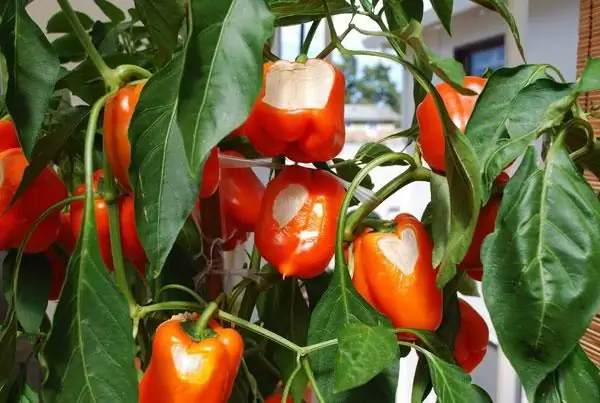
Choose a garden bed
It is best to plan your spring plantings in advance, and for this you need to know what conditions the pepper likes. Growing and caring outdoors is a bit easier than in pots. The main thing that a southern guest needs is warm land with a high content of humus. It is best if the composition is sandy or loamy. That is, moderately loose. Good moisture is required, so peat, turf and leaf humus must be added to too light soils. It is best if legumes grew in the selected area last year. But the tomato bed is not suitable, because they have only one pest.
The soil for planting peppers is prepared in advance. Since autumn, organic matter must be added to the selected bed. For example, rotted manure. This is the best choice for every gardener. It must be applied in an amount of 3-4 kg per square meter. Another option may be straw with the addition of nitrogen components. These are the best fertilizer options for any kind of soil.
Feeding in the ground
It's time to transplant our young peppers into the garden. Cultivation and care in the open field will be largely determined by weather conditions. If the weather is hot and sunny, then you just have to add the necessary nutrients, as well as carry out regular watering. If it is cool outside, then you will have to organize additional protection in the form of a greenhouse or greenhouse. But more on that later.
The first dressing will be required two weeks after the young peppers have moved to the open ground. For this purpose, the following solution is used. For 10 liters, you need to take two teaspoons of carbamide and the same amount of superphosphate. Under each bush, you will need to add approximately one liter of solution.
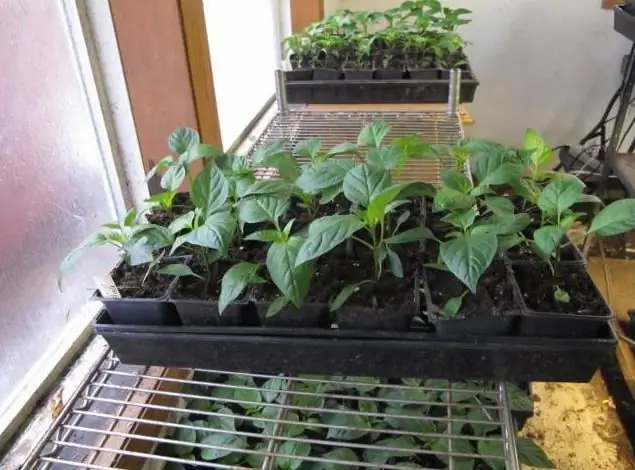
Mass flowering period
This is an important moment, because right now your future harvest is being laid. The formed ovary will now grow and turn into he althy vegetables. So that flowering does not go to waste, it is very important to add potash fertilizers. For pepper, this will be their first application since planting. To prepare a nutrient solution, you will need a teaspoon of potassium sulfate, a similar amount of urea and two tablespoons of superphosphate. Dosage same as firsttop dressing.
Fruit formation
When flowering is over, a small ovary appears on the bushes. Each of these buds can grow into a huge juicy and tasty pepper. For more intensive growth and development, the third top dressing is performed. To do this, for 10 liters of water, you need to take two teaspoons of superphosphate and potassium s alt. If fruit growth is intensive, then this can be limited. But sometimes the gardener notices that, despite all efforts, the ovary continues to hang on the bushes unchanged, or the plant itself has stopped growing. If nothing is done, you can stay at the end of the season with tiny green fruits that are only suitable for winter harvesting. An excellent solution would be foliar top dressing with a solution of urea. It will take 30 g per bucket of water. It is best to do this in the evenings, for 5-7 days.
Schedule of fertilizing in closed ground
Growing plants in a greenhouse has its own specifics. Here the temperature regime is different, which means that the growth of peppers will be more intense. Accordingly, much more nutrients will be required. At the same time, do not forget that organic substances contribute to the productive formation of the crop, and minerals are necessary for proper plant growth. The ideal fertilizer for peppers when planting is an aqueous solution of bird droppings. The concentration should be weak, maximum 1:15. You can also use mullein, here the proportions can be 1:10. These mixtures contain a complete set of nutrients that contribute to the growth and development of crops. If the greenhouse soil is goodmanure since autumn, then you can replace the organics with potassium sulfate with superphosphate.
Mineral fertilizer for greenhouse peppers becomes very important about two weeks after flowering. Now comes the time of active formation and growth of fruits. The best choice would be organic with the addition of mineral fertilizers. By the way, the collection of the first fruits does not at all mean that plant care can be stopped. The third feeding is performed just at this time. The composition can be slightly changed. In some cases, gardeners believe that the best fertilizer for peppers is the above composition. Further top dressing is necessary only if the soil is very poor. A mixture of superphosphate with mineral fertilizers is best here.
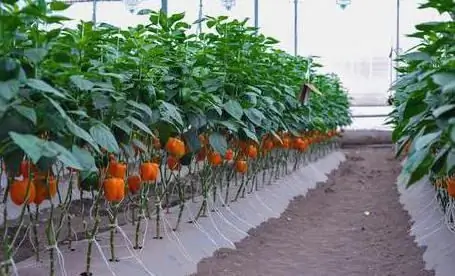
Folk remedies
If you are against the use of chemicals, and there is no way to get rotted manure, then you can use other folk remedies. To do this, one tablespoon of wood ash must be dissolved in two liters of hot water. Mix and leave to brew for a day. Now it remains only to strain and use as intended. Ash as a fertilizer for peppers is a source of essential minerals.
Egg shells can also be used for top dressing. To do this, take the shells of two or three eggs, wash and dry. Now carefully grind, pour into a three-liter jar of water and let it brew for three days, stirring occasionally. During this time, the water will be enriched with magnesium and iron, calcium and potassium. Astop dressing this infusion can be used, breeding one to three.
Another great recipe is an onion peel tincture. It not only saturates the soil with microelements, but also disinfects it, which is especially useful for young plants. It is very easy to prepare it, for this you need to take 20 g of husk per 5 liters of water and insist for five days. If you love coffee, try not to throw away the grounds throughout the year. It is dried and harvested, and then applied to the soil. So it is saturated with nitrogen and oxygen, which is very useful for plants. In addition, gardeners recommend storing dry banana skins. Crushed and added to the soil, they are also an excellent source of potassium and other nutrients.
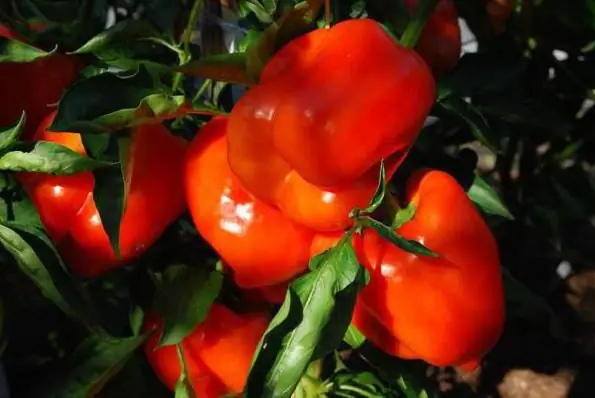
Ready-to-use nutrient complexes
It is difficult to say which option is optimal. Some people prefer to grow their plants exclusively on natural top dressing, such as mullein or bird droppings. Others from early spring stock up on industrial solutions, powders and tablets, which are enough to be diluted in water and applied to the ground. Complex fertilizer for seedlings of tomatoes and peppers can be bought in liquid form or in granules. Trademarks may have different names, but the essence of this does not change. Check out the composition. If it has nitrogen, phosphorus and potassium, then this is exactly the mineral complex that you need. For pepper, the percentage should be N:P:K % 12, 5:17, 5:25. When preparing the soil, fertilizer in the amount of 20-30 g per 1a square meter is evenly scattered over the surface of the earth, and then dug up.
The second stage opens during the growing season. Now the plants are additionally fed with a half dose. That is, 10 g per square meter is already used. The product is applied to moist soil and evenly distributed around, embedding into the soil. In addition, fertilizer is applied in the form of a solution. To do this, you need to take 10 g of powder for seedlings and 20 g for adult plants. A small amount of insoluble residue is acceptable. For seedlings, it is recommended to alternate top dressing with one watering with plain water. For adult plants, it is acceptable to use it with each watering.
Instead of a conclusion
Pepper is a rather capricious crop, so in order to get a good harvest, the gardener must provide all the conditions for it. The southern plant loves hot weather and abundant watering, as well as nutritious soil. If the first two factors are highly dependent on the climatic conditions of the region, then the third one depends entirely on you. The choice of dressings differs in the preferences of the gardener himself. You can ask for humus from a neighbor farmer, supplement it with wood ash and forest humus, and you will get excellent nutrition for your plants. Or you can just buy a special solution or granules in the store, which is enough in excess for the whole season.
And finally, the advice of experienced gardeners. After harvesting, sow the bed where you plan to plant regular barley peppers next season. As soon as the first green appears, mow it down with a sickle and leave it on the ground. It will enrich the soilnodule bacteria and make her he althy.






